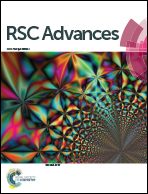Halogenations of substituted 2-alkylquinoline with iodine and halide exchange with AgF2†
Abstract
Halogenations of substituted 2-alkylquinoline with iodine and halide exchange with AgF2 have been developed. These processes provide facile strategies to construct C–I/F bonds, and expand the methods of fluorination of 2-alkylquinolines. These transformations exhibit good tolerance of functional groups and generate the desired products in moderate to good yields.


 Please wait while we load your content...
Please wait while we load your content...